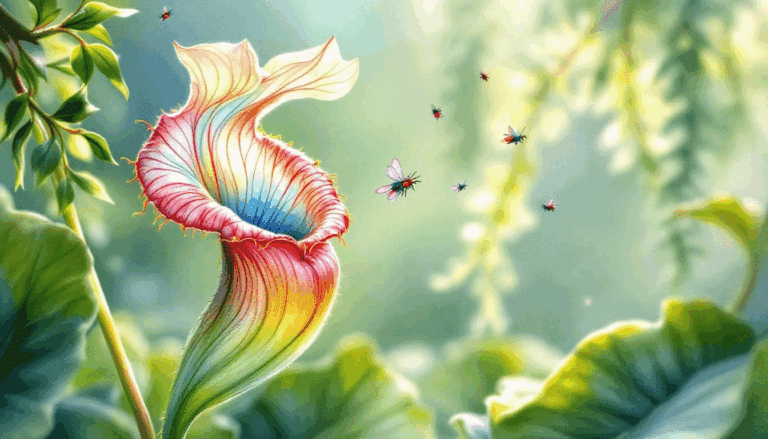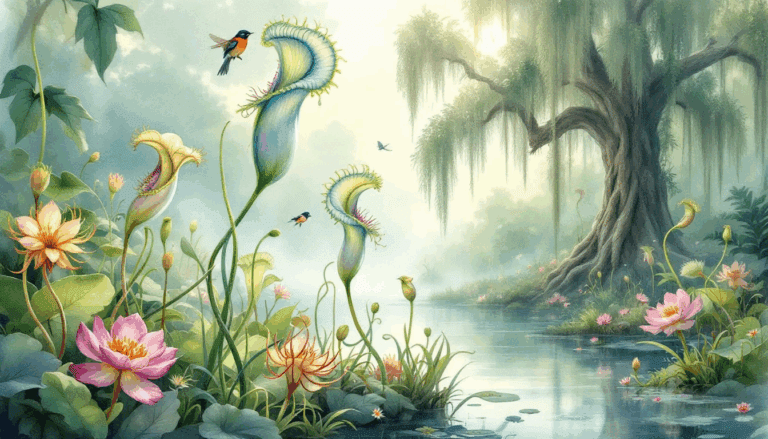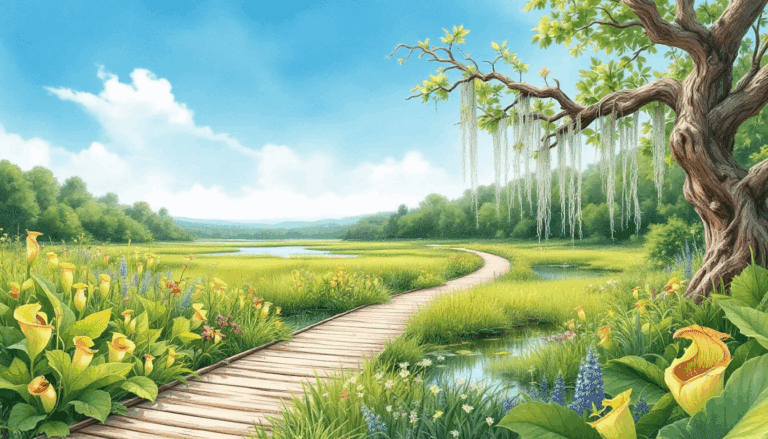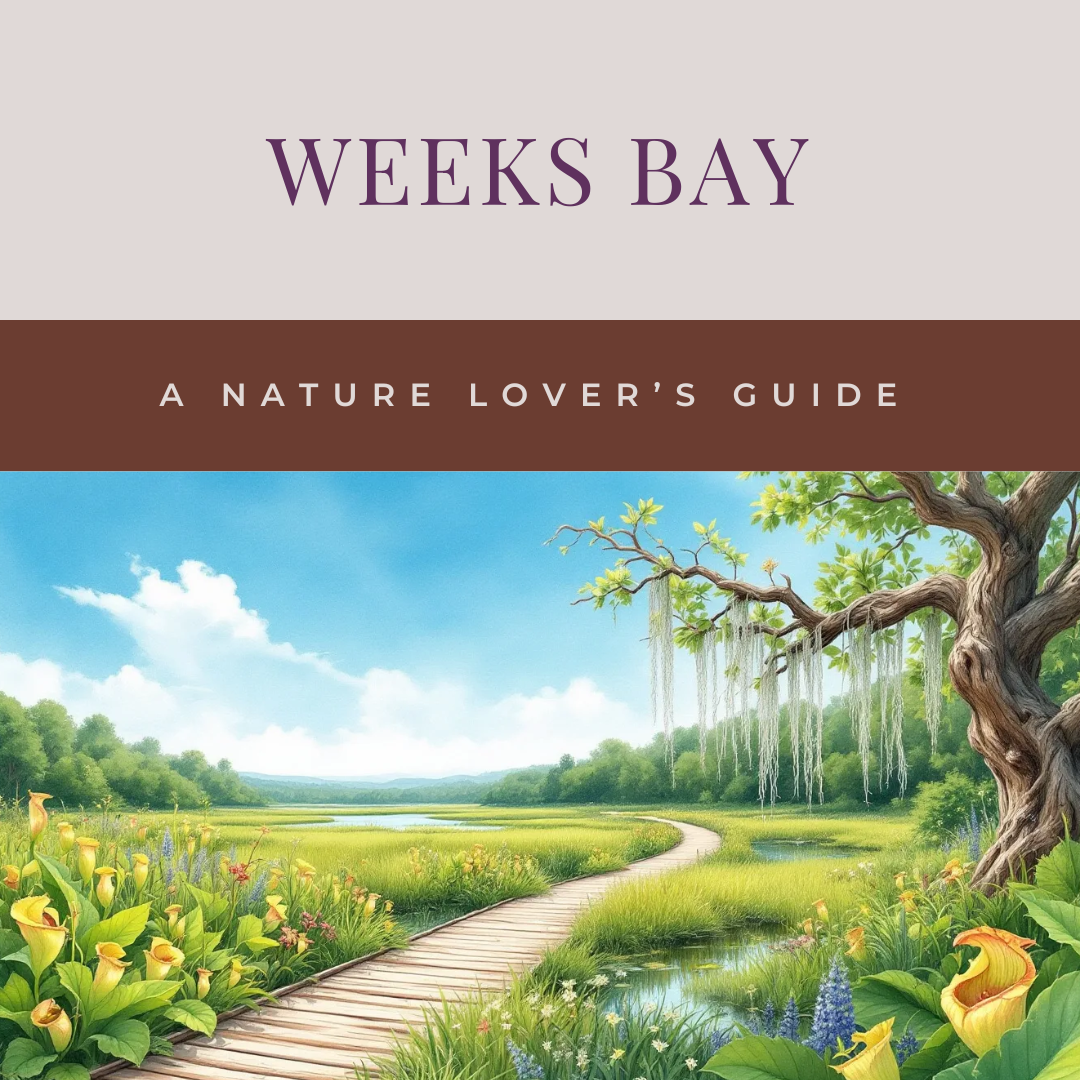Key Takeaways
Weeks Bay Pitcher Plant Bog, located in Alabama’s Weeks Bay National Estuarine Research Reserve, is a must-visit for nature enthusiasts. Known for its rare and intriguing carnivorous plants like the pitcher plant, this bog offers a self-guided trail for up-close exploration. Easily accessible from U.S. Highway 98, the bog invites you to discover its unique ecosystem. This article will detail what makes the bog special, what you can see, and how to plan your visit.
The Weeks Bay Pitcher Plant Bog is a vital ecosystem with diverse plant and animal species, including rare carnivorous pitcher plants, making it a prime location for nature lovers.
Prescribed burns are crucial for maintaining the health of the bog, promoting new growth and preventing wildfires, while conservation efforts engage local communities in stewardship.
Visitors can explore the bog via accessible boardwalks, enjoying seasonal blooms and unique wildlife, with convenient access and amenities for a memorable outdoor experience.
Discovering Weeks Bay Pitcher Plant Bog

Nestled within the expansive Weeks Bay National Estuarine Research Reserve, the Weeks Bay Pitcher Plant Bog is a natural wonder that spans over 6,000 acres. This diverse habitat is crucial for various flowering plants, including rare and endangered species like the Wherry’s Sweet pitcher plant. The bog is a haven for nature enthusiasts, offering a self-guided nature trail that allows visitors to explore its unique ecosystem.
The broader Weeks Bay Reserve, managed by the Alabama Department, covers over 9,300 acres and focuses on preserving the most diverse habitats, including these unique bog habitats. The Reserve’s mission is to enhance the management of estuarine environments through scientific research, public education, and effective stewardship partnerships. Coastal education initiatives aim to reach diverse audiences, promoting conservation awareness and practices throughout the community.
Engaging local communities in conservation activities is a priority for the Alabama Department. By organizing volunteer programs, the department involves locals in preserving the Weeks Bay Reserve. These initiatives help maintain the bog’s health while fostering a strong sense of stewardship and connection to this natural resource.
The Fascinating World of Pitcher Plants

Pitcher plants are one of nature’s most intriguing creations. These carnivorous plants are designed as pitfall traps, featuring a deep cavity filled with digestive liquid that lures and drowns their prey. Their features include:
Bright pigments and nectar that pitcher plants attract insects
UV patterns that enhance their appeal
A slippery rim that makes it nearly impossible for insects to escape once they land on it.
Several species of pitcher plants in the Weeks Bay Pitcher Plant Bog contribute significantly to the area’s ecology in the following ways:
They control insect populations.
They enrich the soil with nutrients.
Some form mutualistic relationships with insects living in their traps, gaining extra nutrients from the waste these insects produce.
Beyond their functional role, pitcher plants enhance the bog’s aesthetic beauty. Their tubular leaves and vibrant colors stand out among other flowering plants and wildflowers. The presence of many orchids and wildflowers further elevates the visual appeal of the Weeks Bay Pitcher Plant Bog, creating a paradise for photographers and nature lovers.
Carnivorous Plants in Weeks Bay

The Weeks Bay Pitcher Plant Bog is home to a variety of carnivorous plants, each with its unique method of capturing prey. Sundews trap insects, belonging to the Drosera genus, are another fascinating example. These plants have modified leaves adorned with tiny tentacles that secrete a sweet substance to attract and ensnare insects. When an insect lands on a sundew, the tentacles bend to trap the prey, a process driven by the release of specific hormones.
Carnivorous plants like sundews and pitcher plants thrive in the nutrient-poor, acidic soils of the Weeks Bay Pitcher Plant Bog. These soils offer them a competitive edge in environments where other plants may struggle. The high humidity and minimal nutrient content create ideal conditions for these plants to flourish.
Carnivorous plants in their natural diverse habitats play a crucial role in maintaining ecological balance. They help control insect populations and contribute to the nutrient cycle within the bog. Their adaptation to these challenging environments showcases nature’s incredible versatility and resilience, including how carnivorous plants obtain interactions with various animals.
The Role of Acidic Soils
One key factor enabling carnivorous plants to thrive in the Weeks Bay Pitcher Plant Bog is the presence of acidic soils. These nutrient-poor soils prompt the plants to derive essential nutrients from the insects they trap. This unique adaptation allows pitcher plants and sundews to survive and even flourish in conditions challenging for most other plants.
The nutrient dynamics in these acidic soils are fascinating. As pitcher plants and other carnivorous species digesting insects their prey, they release nutrients back into the soil, enhancing the ecosystem’s overall health.
Sundews, for instance, grow in waterlogged environments and utilize their carnivorous traits to obtain the nutrients they need. This symbiotic relationship between the plants and their environment underscores the delicate balance of the natural resources bogs ecosystem.
The Importance of Prescribed Burns
In the Weeks Bay Pitcher Plant Bog, prescribed burns play a vital role in maintaining the health and biodiversity of the ecosystem. These burn are strategically conducted to restore and rejuvenate habitats, promoting the growth of native plants and supporting rare species like the red-cockaded woodpecker. By carefully managing these controlled fires, conservationists can create conditions that favor the unique flora and fauna of the bog.
Effective management of prescribed burns requires careful coordination with multiple agencies and consideration of specific weather conditions. These controlled burns help prevent devastating wildfires by reducing the accumulation of combustible materials. They also stimulate new plant growth, creating a dynamic and resilient ecosystem that benefits both wildlife and human communities.
Seasonal Changes and Blooming
The Weeks Bay Pitcher Plant Bog offers a dynamic and ever-changing landscape, with each season bringing its unique beauty. In early spring, the first blooms of pitcher plants begin to appear, signaling the start of the blooming season. This is a magical time to visit, as the bog comes alive with a variety of wildflowers and other flowering plants.
As spring progresses into summer, many orchids and other wildflowers blossom, adding vibrant colors to the landscape. Late spring and summer are particularly notable for the diverse array of orchid species that bloom during these months. The bog’s unique flora attracts a range of pollinators, including butterflies and other small creatures, creating a lively and vibrant ecosystem.
The Weeks Bay Pitcher Plant Bog can be visited year-round, offering unique experiences in each season:
Spring: Witness the early emergence of wildflowers
Summer: Enjoy the full bloom of orchids
Fall: See the changing colors of the season There’s always something new and exciting to discover. Don’t forget your camera to capture the stunning beauty of this natural wonder.
Exploring the Pitcher Plant Bog Boardwalk

Exploring the elevated boardwalk is one of the best ways to experience the Weeks Bay Pitcher Plant Bog. The boardwalk offers:
Accessible pathways, making it easy for families and individuals of all ages to walk and explore
Opportunities to observe pitcher plants and other wetland species up close
A unique perspective on this fascinating ecosystem
From the boardwalk, visitors can enjoy views of the river that flows into Mobile Bay, adding to the scenic beauty of the experience. Although the immediate area may not have much visual interest, the boardwalk offers a tranquil and immersive way to connect with nature. It’s a perfect spot for bird-watching, photography, or simply enjoying a peaceful stroll.
Currently, the Weeks Bay Pitcher Plant Bog boardwalk and park parking are under renovation, with expected reopening once construction is complete. During this time, visitors can explore the boardwalk and trails at the nearby Weeks Bay Visitor Center. Be sure to check for updates on the status of the boardwalk and parking area before planning your visit.
Conservation Efforts by the Alabama Department
The conservation efforts at the Weeks Bay Pitcher Plant Bog are a testament to the dedication and hard work of the Alabama Department and its partners. The Weeks Bay Reserve emphasizes the protection and study of estuarine ecosystems, supporting a diverse array of wildlife and plant communities. This vibrant estuarine system is home to numerous species, each playing a vital role in the health of the ecosystem.
Prescribed burns are a critical part of the conservation strategy, helping to:
Rejuvenate natural food sources
Prevent devastating wildfires
Stimulate new plant growth, providing habitat and food for various wildlife, including deer and nesting birds
The Reserve also conducts long-term monitoring programs to assess the health of the Weeks Bay ecosystem and its surrounding watershed.
Education initiatives and stewardship programs play a crucial role in fostering a sense of responsibility and connection to the natural world. By engaging the community and promoting conservation practices, the Alabama Department ensures that the Weeks Bay Pitcher Plant Bog facilities serve as a thriving and resilient ecosystem for future generations.
Visitor Information
Planning a visit to the Weeks Bay Pitcher Plant Bog is easy with a bit of practical information:
The bog can be found on County Road 17.
It is located roughly a quarter mile north of U.S. Highway 98.
Clear signage marks the entrance.
Parking is available in a designated lot on the east side of County Road 17, making it convenient for visitors to access the bog and its amenities.
The Weeks Bay Reserve aims to safeguard land and foster environmental education in coastal Alabama, ensuring access to clean water, wildlife, and outdoor recreational opportunities for residents. Established in 1990 as a non-profit organization, it has successfully preserved over 11,000 acres of coastline in Baldwin and Mobile counties.
Visitors can also look forward to special events like the Bald Eagle Bash, scheduled for April 26, 2025. This event features local seafood, brews, and talent in a scenic setting by Weeks Bay, offering a unique and enjoyable way to support conservation efforts.
Summary
The Weeks Bay Pitcher Plant Bog is a remarkable natural treasure, offering a unique glimpse into the world of carnivorous plants and diverse flora. From the fascinating pitcher plants to the vibrant wildflowers and orchids, this bog is a testament to nature’s ingenuity and resilience. The conservation efforts led by the Alabama Department ensure that this unique ecosystem remains healthy and thriving for future generations to enjoy.
Whether you’re a nature lover, a photographer, or simply looking for a peaceful escape, the Weeks Bay Pitcher Plant Bog offers something for everyone. By visiting and supporting conservation initiatives, you can help preserve this enchanting habitat and ensure its beauty for years to come.
Frequently Asked Questions
Where is the Weeks Bay Pitcher Plant Bog located?
The Weeks Bay Pitcher Plant Bog is located on County Road 17, just a quarter mile north of U.S. Highway 98 in Alabama. It’s definitely worth checking out if you’re in the area!
What makes pitcher plants unique?
Pitcher plants are unique because they trap and digest insects to obtain essential nutrients, making them fascinating carnivorous plants. Their specialized pitfall traps are what set them apart in the plant kingdom.
Why are prescribed burns important for the bog?
Prescribed burns are crucial for the bog because they prevent wildfires, encourage new plant growth, and boost biodiversity, helping to maintain a healthy ecosystem. Keeping this balance is essential for the survival of various species and the overall health of the environment.
When is the best time to visit the Weeks Bay Pitcher Plant Bog?
The best time to visit the Weeks Bay Pitcher Plant Bog is early spring when the pitcher plants and wildflowers are in full bloom. You won’t want to miss the vibrant colors and unique sights!
What conservation efforts are in place at Weeks Bay?
Weeks Bay is supported by conservation efforts including research, water quality monitoring, educational programs, and prescribed burns to keep the ecosystem healthy. These initiatives ensure the area’s natural beauty and biodiversity are preserved for future generations.
More in the Hidden Gems series HERE

